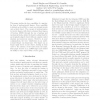Free Online Productivity Tools
i2Speak
i2Symbol
i2OCR
iTex2Img
iWeb2Print
iWeb2Shot
i2Type
iPdf2Split
iPdf2Merge
i2Bopomofo
i2Arabic
i2Style
i2Image
i2PDF
iLatex2Rtf
Sci2ools
ICRA
2003
IEEE
2003
IEEE
On the force capability of underactuated fingers
This paper studies the force capability of a particular class of underactuated fingers. Force capability is defined as the ability to create an external wrench onto a fixed object. The concept of underactuation in robotic fingers, with fewer actuators than degrees of freedom (DOF) through the use of springs and mechanical limits, allows the hand to adjust itself to an irregularly shaped object without complex control strategy and numerous sensors. However, in some configurations, the force distribution in an underactuated finger can degenerate. The finger can no longer apply forces on the object, leading in some cases to the ejection of the latter from the hand. This paper focuses on a 2-DOF finger and studies its ability to seize objects with a secure grasp.
| Added | 04 Jul 2010 |
| Updated | 04 Jul 2010 |
| Type | Conference |
| Year | 2003 |
| Where | ICRA |
| Authors | Lionel Birglen, Clément Gosselin |
Comments (0)

